Kanagawa Castle
-Fall just one step short of survival-
Overview
Name: Kanagawa castle (Kanagawa-jo)
Alias: Tamamatsu-jo (Tamamatsu-castle)
Place: Mitsu-Kanagawa Kita-ku Okayama city, Okayama
Location: 34.802906067129996, 133.93216085541775
Type: Mountain Castle
Built: 1480
Remaining remnants: Stone walls, clay walls and dry moats
Title:
Kanagawa castle (金川城, no relationship with Kanagawa prefecture) is located on Shiroyama mountain, one of about 200 meter height from hillside at the meeting point of Asahi-gawa river and its tributary Ukai-gawa river at about 10 kilometer north of central Okayama city. Asahi-gawa river is one of three rivers flows from Chugoku mountains toward Setonaikai Sea and form Okayama plain, along with Yoshii-gawa river at east and Takahashi-gawa river at west.
Same as Tenjinyama castle beside Yoshii-gawa river and Bicchu Matsuyama castle at the side of Takahashi-gawa river, Kanagawa castle had a role to control the communication between Okayama plain and Mimasaka basin, a mountainous area which was the connecting point toward Sanin region at the eastern half of Chugoku region. Mimasaka basin itself is formed by Yoshii-gawa river, but Asahi-gawa river route is the shortest one and even now used as Tsuyamasa-sen line.
In addition, Ukai-gawa river which flows from Kibi-Kogen height is a path to the northern part of Bicchu province toward Takahashi-gawa river, and at the northeast of Kanagawa castle the area of Asahi-gawa river and Yoshii-gawa-river also adjoined. Because of this geographical reason, castle site is a crossing point at the middle of Bizen province (eastern part of Okayama prefecture) and an important point of communication.
Precise year is unknown but it is said that Kanagawa castle was built by local lord Matsuda clan in 1355. Matsuda clan is said as a descendant of Hidesato Fujiwara (?-?) who was a military noble activated at subjugation of the rebellion of Masakado Taira (?-940) and became the leader of local militants in Eastern provinces. Among many descendants of Fujisato, one family lived at Hatano area of current Kanagawa prefecture and named as Hatano clan.
One of their branch family also lived at Matsuda area at the north of Odawara city and named as Matsuda clan. Matsuda clan supported Yoritomo Minamoto (1147-1199), the founder of Kamakura Shogunate, and became one of their major retainers at Sagami province. Matsuda clan also activated at the battle of Jokyu between Kamakura Shogunate and supporters of Imperial Household in 1221, then achieved north part of current Okayama city.
But at the fall of Kamakura Shogunate in 1333, Matsuda clan belonged to Yoshisada Nitta (1301-1338), a large load of Kamakura Shogunate but rebelled and finally captured Kamakura city and ruined the Shogunate. At the conflict of Yoshisada Nitta and Takauji Ashikaga (1305-1358), who once supported Emperor Godaigo (1305-1358) along with Yoshisada and once ruined Kamakura Shogunate but later left Emperor and opened his own Muromachi Shogunate.
Matsuda clan bravely fought at inferior Nitta clan. Main family of Matsuda clan at Sagami province once lost their power at the fall of Yoshisada, but later became an important retainer of Hojo clan which was the lord of Odawara castle and Norihide Matsuda (?-1590) became the highest retainer of Hojo clan but was killed by the suspect of betrayal at the siege of Odawara castle by central ruler Hideyoshi Toyotomi (1537-1598) in 1590.
Contrary to main family at Sagami province, branch family of Matsuda clan at Bizen province belonged to Takauji Ashikaga then became a retainer of Muromachi Shogunate. Matsuda clan built their main base Tomiyama castle and was once appointed as the governor of Bizen province, but later became the retainer of Akamatsu clan which was a close retainer of Muromachi Shogunate and held provinces at Sanyo area.
Akamatsu clan once prospered as the strong lord of Muromachi Shogunate, but later being suppressed by sixth shogun Yoshinori Ashikaga (1394-1441) then assassinated Yoshinori in 1441. Akamatsu clan was once subjugated as a rebel, but later restored by contribution to Muromachi Shogunate. Furthermore, Akamatsu clan fought as a main force of Eastern army at the battle of Onin between 1467 and 1477, then returned as the governor of their former territory Harima province, Bizen province and Mimasaka province.
But after the death of Masanori Akamatsu (1455-1496) who deprived Bizen province from Yamana clan and built a despotic power of the lord at Akamatsu clan, the clan fell into disorder by internal conflict for successor. Looking at this situation, Uragami clan which was the lord of Mitsuishi castle (Okayama prefecture) and deputy governor of Bizen province, seized authority at Akamatsu clan and rejected the counter attack of Yoshimura Akamatsu (?-1521), son of Masanori and who tried to retrieve the authority.
At the same time, Matsuda clan gradually grew their power at the western part of Bizen province, and moved their main base to Kanagawa castle in 1480. From Kanagawa castle, Matsuda clan captured wide area at the north of Okayama plain by branch castles.
In 1483, Masanori Akamatsu who feared growth of Matsuda clan ordered Uragami clan to attack Matsuda clan, but Matsuda clan rejected this attack under the support of Yamana clan. Matsuda clan rejected this attack of Uragami clan in turn siege Mitsuishi castle which was the main base of Uragami clan, but suffered severe defeat by Uragami army then the Motonari Matsuda (?-1484), the leader of Matsuda clan killed himself.
However, Matsuda clan itself survived under Motofuji Matsuda (?-?), son of Motonari. Under the support of Yamana clan, Matsuda clan rejected continuous attack of Uragami clan and virtually became an independent lord at the western half of Bizen province.
Next Motofuji attempted to ruin Uragami clan and made decisive battle in 1502, but because of the brave fight of Yoshiie Ukita (?-1531?), who was the retainer of Uragami clan and grandfather of Naoie Ukita (1529-1582) who later ruined Matsuda clan, Matsuda clan could not break Uragami army. But Motofuji became a direct retainer of Muromachi Shogunate and married with a daughter of central noble.
However, at the period of Motomichi Matsuda (?-1531), son of Motofuji, Matsuda clan and Uragami clan allied to reject the power of Akamatsu clan. At the invasion of Amago clan which was the strong warlord of Izumo province (Shimane prefecture) in 1551, Matsuda clan belonged to Amago clan and conflicted with Uragami clan which resisted to Amago clan under the support of Mouri clan.
At this point, Matsuda clan was only one step away from the warlord of whole Bizen province. But their supporter Amago clan became inferior at the battle against Mouri clan which belonged to Ouchi clan, the warlord of Suo province (Yamaguchi prefecture) and fatal rival of Amago clan, then retreated from Bingo province at the incident of disorder at Ouchi clan in 1555.
Uragami clan which recovered Bizen province and became an independent warlord at Tenjinyama castle let their retainer Naoie Ukita to attack Matsuda clan, and Mototeru Matsuda (?-1568) lost territories before continuous attack of Naoie but kept resistance.
Looking at the stubbornness of Matsuda clan, Naoie once allied with Matsuda clan by marriage of his daughter with Motokata Matsuda (?-1568), son of Mototeru. But Naoie gradually grew his power ruining neighbor lords such as Nakayama clan at Numa castle, Kanamitsu clan at Okayama castle or Saisho clan at Tatsunokuchi castle by plots or assassination. Furthermore, Naoie rejected attack of Mimura clan which was the lord of Bicchu Matsuyama castle and intended to intrude into Bizen province.
Around this time, Matsuda clan fall into disorder became of their religious policy. In 1568, looking at the decline of Matsuda clan, Naoie assassinated important retainer at the hunting with Matsuda clan and claimed it as misfire, then next turned Iga clan which was the important retainer of Kanagawa clan to Ukita clan.
After these preparation, Naoie Ukita made total attack to Kanagawa castle. Mototeru Matsuda and Motokata Matsuda desperately resisted at Kanagawa castle, but Mototeru was shot by Ukita army, then Motokata left Kanagawa castle and tried to escape but was found and died in the melee. Daughter of Naoie who heard her husband was killed by his father killed herself and followed his husband. As such, Matsuda clan had a history over 300 years disappeared from history.
After the fall, Naoie Ukita continuously used Kanagawa castle as an important front base to protect Okayama basin, toward Mimura clan at Bicchu Matsuyama castle or his former master Uragami clan at Tenjinyama castle. Later when Ukita clan conflicted with Mouri clan, Kanagawa castle became the front against Mouri clan which suppressed Ukita clan from north and west. Naoie Ukita and his son Hideie Ukita (1572-1655) reformed Kanagawa castle into a modern one.
Kanagawa castle spreads over T letter shaped ridge consist of main body at vertical line and two outer area at both side of horizontal line, faces northwest. Central area of the castle is a rectangular area of 60 meter long and 20 meter wide, which is protected by clay wall and has a Masugata style complex gate with folded path and barrack gate at its southeast edge.
Whole side wall of central area might be guarded by stone walls, and at the below of northern line there is a huge hole of well which is about 10 meter diameter. Many pieces of stone are scattered around the area, and this might be the sign of destruction at the abolition. At the southwest of central area, there is the secondary area of 200 meter long and 40 meter wide, which is separated into upper layer and lower layer by stone walls and had the main gate at its southeastern edge.
At the north of central area, there is Kitanomaru area which consist of several terraces. This area keeps the atmosphere of Matsuda clan, and separated from backside mountain by combination of two deep dry moat. On the other hand, Dorinjimaru area at the southwest of central area was the main route from hillside, and used as a temple at Matsuda period or residence of the lord at Ukita period. Well shaped terrace and line of stone wall shows reform at Ukita period.
Total size of the castle reached to 500 meter long and 400 meter wide, and even though smaller than Tenjinyama castle or Bicchu Matsuyama castle which are extraordinary huge ones, size and structure of Kanagawa castle is the first class medieval castle of the area.
Ukita clan held Bizen province including Kanagawa castle by 1600, but as a result of the battle of Sekigahara their territory was confiscated. Hideaki Kobayakawa (1582-1602) who held Bizen province kept Kanagawa castle and Shimotsui castle as branch castles other than his main base Okayama castle. Hideaki placed his important retainer Masashige Inaba (1571-1628) as a commander of Kanagawa castle, but later Masashige left Kobayakawa clan.
Soon Kobayakawa clan became extinct because of the death of Hideaki, then Ikeda clan which was the lord of Himeji castle moved to Bizen province. Kanagawa castle might be abolished by Ikkoku Ichijo Rei (one domain one castle rule) placed in 1615, but later Ikeda clan built administrative office at the side of Shiroyama mountain.
Now all building was lost but shape of the castle well remain on the mountain. Large and shaped stones which are wreck of stone walls are seen here and there of the castle, and along with slightly remaining stone walls, it brings the image of former magnificent shape of the castle. Matsuda clan and Kanagawa clan ended their history just one step away from survival, but ruin of Kanagawa castle tells memory of lost clan and castle eloquently until now.
15 minutes walk from JR West Tsuyama-sen line Kanagawa station to hillside entrance at the backside of Myokakuji temple. 15 minutes drive from Sanyo-Jidoshado Expressway Sanyo interchange. 30 minutes walk from hillside to hilltop castle.
Type: Mountain Castle
Built: 1480
Remaining remnants: Stone walls, clay walls and dry moats
Title:
Brief History
Kanagawa castle (金川城, no relationship with Kanagawa prefecture) is located on Shiroyama mountain, one of about 200 meter height from hillside at the meeting point of Asahi-gawa river and its tributary Ukai-gawa river at about 10 kilometer north of central Okayama city. Asahi-gawa river is one of three rivers flows from Chugoku mountains toward Setonaikai Sea and form Okayama plain, along with Yoshii-gawa river at east and Takahashi-gawa river at west.
Same as Tenjinyama castle beside Yoshii-gawa river and Bicchu Matsuyama castle at the side of Takahashi-gawa river, Kanagawa castle had a role to control the communication between Okayama plain and Mimasaka basin, a mountainous area which was the connecting point toward Sanin region at the eastern half of Chugoku region. Mimasaka basin itself is formed by Yoshii-gawa river, but Asahi-gawa river route is the shortest one and even now used as Tsuyamasa-sen line.
In addition, Ukai-gawa river which flows from Kibi-Kogen height is a path to the northern part of Bicchu province toward Takahashi-gawa river, and at the northeast of Kanagawa castle the area of Asahi-gawa river and Yoshii-gawa-river also adjoined. Because of this geographical reason, castle site is a crossing point at the middle of Bizen province (eastern part of Okayama prefecture) and an important point of communication.
Origin of Matsuda clan
Precise year is unknown but it is said that Kanagawa castle was built by local lord Matsuda clan in 1355. Matsuda clan is said as a descendant of Hidesato Fujiwara (?-?) who was a military noble activated at subjugation of the rebellion of Masakado Taira (?-940) and became the leader of local militants in Eastern provinces. Among many descendants of Fujisato, one family lived at Hatano area of current Kanagawa prefecture and named as Hatano clan.
One of their branch family also lived at Matsuda area at the north of Odawara city and named as Matsuda clan. Matsuda clan supported Yoritomo Minamoto (1147-1199), the founder of Kamakura Shogunate, and became one of their major retainers at Sagami province. Matsuda clan also activated at the battle of Jokyu between Kamakura Shogunate and supporters of Imperial Household in 1221, then achieved north part of current Okayama city.
But at the fall of Kamakura Shogunate in 1333, Matsuda clan belonged to Yoshisada Nitta (1301-1338), a large load of Kamakura Shogunate but rebelled and finally captured Kamakura city and ruined the Shogunate. At the conflict of Yoshisada Nitta and Takauji Ashikaga (1305-1358), who once supported Emperor Godaigo (1305-1358) along with Yoshisada and once ruined Kamakura Shogunate but later left Emperor and opened his own Muromachi Shogunate.
Branch family at Bizen province
Matsuda clan bravely fought at inferior Nitta clan. Main family of Matsuda clan at Sagami province once lost their power at the fall of Yoshisada, but later became an important retainer of Hojo clan which was the lord of Odawara castle and Norihide Matsuda (?-1590) became the highest retainer of Hojo clan but was killed by the suspect of betrayal at the siege of Odawara castle by central ruler Hideyoshi Toyotomi (1537-1598) in 1590.
Contrary to main family at Sagami province, branch family of Matsuda clan at Bizen province belonged to Takauji Ashikaga then became a retainer of Muromachi Shogunate. Matsuda clan built their main base Tomiyama castle and was once appointed as the governor of Bizen province, but later became the retainer of Akamatsu clan which was a close retainer of Muromachi Shogunate and held provinces at Sanyo area.
Akamatsu clan once prospered as the strong lord of Muromachi Shogunate, but later being suppressed by sixth shogun Yoshinori Ashikaga (1394-1441) then assassinated Yoshinori in 1441. Akamatsu clan was once subjugated as a rebel, but later restored by contribution to Muromachi Shogunate. Furthermore, Akamatsu clan fought as a main force of Eastern army at the battle of Onin between 1467 and 1477, then returned as the governor of their former territory Harima province, Bizen province and Mimasaka province.
Confrontation with Uragami clan
But after the death of Masanori Akamatsu (1455-1496) who deprived Bizen province from Yamana clan and built a despotic power of the lord at Akamatsu clan, the clan fell into disorder by internal conflict for successor. Looking at this situation, Uragami clan which was the lord of Mitsuishi castle (Okayama prefecture) and deputy governor of Bizen province, seized authority at Akamatsu clan and rejected the counter attack of Yoshimura Akamatsu (?-1521), son of Masanori and who tried to retrieve the authority.
At the same time, Matsuda clan gradually grew their power at the western part of Bizen province, and moved their main base to Kanagawa castle in 1480. From Kanagawa castle, Matsuda clan captured wide area at the north of Okayama plain by branch castles.
In 1483, Masanori Akamatsu who feared growth of Matsuda clan ordered Uragami clan to attack Matsuda clan, but Matsuda clan rejected this attack under the support of Yamana clan. Matsuda clan rejected this attack of Uragami clan in turn siege Mitsuishi castle which was the main base of Uragami clan, but suffered severe defeat by Uragami army then the Motonari Matsuda (?-1484), the leader of Matsuda clan killed himself.
Peak of Matsuda clan
However, Matsuda clan itself survived under Motofuji Matsuda (?-?), son of Motonari. Under the support of Yamana clan, Matsuda clan rejected continuous attack of Uragami clan and virtually became an independent lord at the western half of Bizen province.
Next Motofuji attempted to ruin Uragami clan and made decisive battle in 1502, but because of the brave fight of Yoshiie Ukita (?-1531?), who was the retainer of Uragami clan and grandfather of Naoie Ukita (1529-1582) who later ruined Matsuda clan, Matsuda clan could not break Uragami army. But Motofuji became a direct retainer of Muromachi Shogunate and married with a daughter of central noble.
However, at the period of Motomichi Matsuda (?-1531), son of Motofuji, Matsuda clan and Uragami clan allied to reject the power of Akamatsu clan. At the invasion of Amago clan which was the strong warlord of Izumo province (Shimane prefecture) in 1551, Matsuda clan belonged to Amago clan and conflicted with Uragami clan which resisted to Amago clan under the support of Mouri clan.
Fall and ally with Naoie Ukita
At this point, Matsuda clan was only one step away from the warlord of whole Bizen province. But their supporter Amago clan became inferior at the battle against Mouri clan which belonged to Ouchi clan, the warlord of Suo province (Yamaguchi prefecture) and fatal rival of Amago clan, then retreated from Bingo province at the incident of disorder at Ouchi clan in 1555.
Uragami clan which recovered Bizen province and became an independent warlord at Tenjinyama castle let their retainer Naoie Ukita to attack Matsuda clan, and Mototeru Matsuda (?-1568) lost territories before continuous attack of Naoie but kept resistance.
Looking at the stubbornness of Matsuda clan, Naoie once allied with Matsuda clan by marriage of his daughter with Motokata Matsuda (?-1568), son of Mototeru. But Naoie gradually grew his power ruining neighbor lords such as Nakayama clan at Numa castle, Kanamitsu clan at Okayama castle or Saisho clan at Tatsunokuchi castle by plots or assassination. Furthermore, Naoie rejected attack of Mimura clan which was the lord of Bicchu Matsuyama castle and intended to intrude into Bizen province.
Downfall by father-in-law
Around this time, Matsuda clan fall into disorder became of their religious policy. In 1568, looking at the decline of Matsuda clan, Naoie assassinated important retainer at the hunting with Matsuda clan and claimed it as misfire, then next turned Iga clan which was the important retainer of Kanagawa clan to Ukita clan.
After these preparation, Naoie Ukita made total attack to Kanagawa castle. Mototeru Matsuda and Motokata Matsuda desperately resisted at Kanagawa castle, but Mototeru was shot by Ukita army, then Motokata left Kanagawa castle and tried to escape but was found and died in the melee. Daughter of Naoie who heard her husband was killed by his father killed herself and followed his husband. As such, Matsuda clan had a history over 300 years disappeared from history.
After the fall, Naoie Ukita continuously used Kanagawa castle as an important front base to protect Okayama basin, toward Mimura clan at Bicchu Matsuyama castle or his former master Uragami clan at Tenjinyama castle. Later when Ukita clan conflicted with Mouri clan, Kanagawa castle became the front against Mouri clan which suppressed Ukita clan from north and west. Naoie Ukita and his son Hideie Ukita (1572-1655) reformed Kanagawa castle into a modern one.
Structure of Kanagawa castle
Kanagawa castle spreads over T letter shaped ridge consist of main body at vertical line and two outer area at both side of horizontal line, faces northwest. Central area of the castle is a rectangular area of 60 meter long and 20 meter wide, which is protected by clay wall and has a Masugata style complex gate with folded path and barrack gate at its southeast edge.
Whole side wall of central area might be guarded by stone walls, and at the below of northern line there is a huge hole of well which is about 10 meter diameter. Many pieces of stone are scattered around the area, and this might be the sign of destruction at the abolition. At the southwest of central area, there is the secondary area of 200 meter long and 40 meter wide, which is separated into upper layer and lower layer by stone walls and had the main gate at its southeastern edge.
At the north of central area, there is Kitanomaru area which consist of several terraces. This area keeps the atmosphere of Matsuda clan, and separated from backside mountain by combination of two deep dry moat. On the other hand, Dorinjimaru area at the southwest of central area was the main route from hillside, and used as a temple at Matsuda period or residence of the lord at Ukita period. Well shaped terrace and line of stone wall shows reform at Ukita period.
Total size of the castle reached to 500 meter long and 400 meter wide, and even though smaller than Tenjinyama castle or Bicchu Matsuyama castle which are extraordinary huge ones, size and structure of Kanagawa castle is the first class medieval castle of the area.
Afterward of castle
Ukita clan held Bizen province including Kanagawa castle by 1600, but as a result of the battle of Sekigahara their territory was confiscated. Hideaki Kobayakawa (1582-1602) who held Bizen province kept Kanagawa castle and Shimotsui castle as branch castles other than his main base Okayama castle. Hideaki placed his important retainer Masashige Inaba (1571-1628) as a commander of Kanagawa castle, but later Masashige left Kobayakawa clan.
Soon Kobayakawa clan became extinct because of the death of Hideaki, then Ikeda clan which was the lord of Himeji castle moved to Bizen province. Kanagawa castle might be abolished by Ikkoku Ichijo Rei (one domain one castle rule) placed in 1615, but later Ikeda clan built administrative office at the side of Shiroyama mountain.
Now all building was lost but shape of the castle well remain on the mountain. Large and shaped stones which are wreck of stone walls are seen here and there of the castle, and along with slightly remaining stone walls, it brings the image of former magnificent shape of the castle. Matsuda clan and Kanagawa clan ended their history just one step away from survival, but ruin of Kanagawa castle tells memory of lost clan and castle eloquently until now.
Access
15 minutes walk from JR West Tsuyama-sen line Kanagawa station to hillside entrance at the backside of Myokakuji temple. 15 minutes drive from Sanyo-Jidoshado Expressway Sanyo interchange. 30 minutes walk from hillside to hilltop castle.






















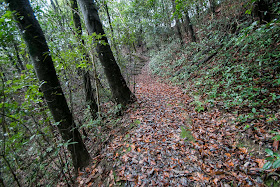





















































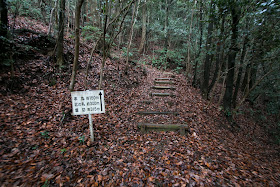


























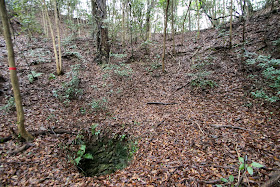

















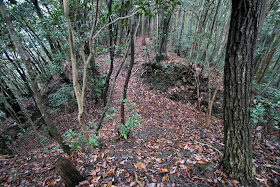














































































































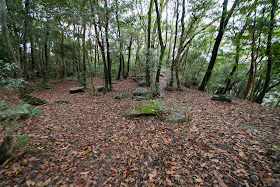

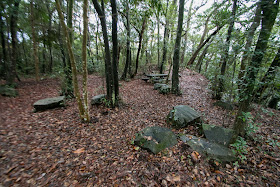









































































































No comments:
Post a Comment